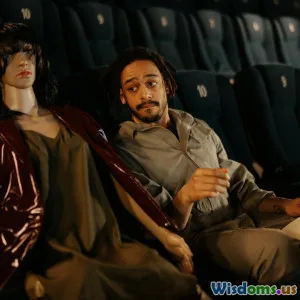
From Theaters to Screens: The Journey of a Film
6 min read Explore the intricate journey of a film from production to screen, highlighting key stages and the evolution of film distribution. (0 Reviews)
From Theaters to Screens: The Journey of a Film
The journey of a film is an intricate tapestry woven from creativity, technology, and audience engagement. From the initial concept to the grand premiere and eventual viewing at home, this article will explore each stage of this fascinating journey, shedding light on how films transition from theaters to screens, and the evolving landscape of film distribution and consumption.
1. The Concept and Development Stage
Every film begins with an idea—a spark of creativity that evolves into a full-fledged script. This stage often involves:
- Screenwriting: Writers create scripts, which are often revised multiple times. Successful screenplays balance character development, dialogue, and plot structure.
- Pitching: Screenwriters present their scripts to producers and studios. A compelling pitch is crucial for securing funding and attracting talent.
- Pre-production Planning: Once a script is greenlit, the production team begins planning. This includes casting, budget allocation, scouting locations, and scheduling shoots.
2. Production: Bringing the Script to Life
Production is where the magic happens. This phase commonly includes:
- Filming: Directors work with actors and crew to capture footage based on the script. This process can take weeks or months, depending on the film's scale.
- Technical Aspects: Cinematography, sound recording, and lighting play vital roles in capturing the film's visual and auditory essence. Each element contributes to the overall mood and storytelling.
- Direction: The director’s vision guides the production, influencing every aspect from performance to camera angles.
3. Post-Production: The Finishing Touches
After filming wraps, the film moves into post-production, which is crucial for polishing the final product:
- Editing: Editors assemble the footage to create a cohesive narrative. This stage involves cutting scenes, adding transitions, and pacing the film.
- Visual Effects: Many films incorporate CGI or other visual effects, requiring specialized teams to enhance the viewer's experience.
- Sound Design: Sound editors add sound effects and music to create an immersive audio landscape. The score, often composed specifically for the film, plays a significant role in evoking emotions.
4. Distribution: Getting the Film to Audiences
Once the film is complete, the next challenge is distribution—getting the film to audiences:
- Theatrical Release: Traditionally, films debut in theaters. Distribution companies negotiate contracts, decide on release dates, and plan marketing strategies to maximize audience turnout.
- Film Festivals: Many filmmakers first showcase their work at festivals, which can lead to wider distribution deals. Festivals like Sundance and Cannes are known for launching independent films.
- Digital Release: With the rise of streaming platforms, films are now often released digitally. This has transformed the landscape, allowing for immediate access to audiences worldwide.
5. The Streaming Revolution
The advent of streaming services like Netflix, Amazon Prime, and Disney+ has dramatically altered how films are consumed:
- Accessibility: Audiences can now watch films from the comfort of their homes, leading to a more personalized viewing experience.
- Diverse Offerings: Streaming platforms offer a wide variety of genres and international films that might not have received theatrical distribution.
- Changing Business Models: The traditional box office revenue model is adapting as studios explore hybrid releases that blend theatrical and digital strategies.
6. The Future of Film Distribution
As technology continues to evolve, so does the film industry:
- Virtual Reality and Interactive Films: Emerging technologies are shaping new forms of storytelling, allowing audiences to engage with content in innovative ways.
- Global Distribution: Filmmakers can now reach international audiences faster and more efficiently, enhancing the global film market.
- Data Analytics: Studios are increasingly using data to understand viewer preferences and tailor marketing strategies, ensuring films reach their target demographics.
Conclusion
The journey of a film from theaters to screens is a multifaceted process that showcases the collaboration of numerous creative and technical professionals. As the landscape of film distribution continues to change, filmmakers and audiences alike are adapting to a new era of storytelling that prioritizes accessibility and innovation. Understanding this journey not only enhances appreciation for the art of filmmaking but also underscores the importance of adaptability in an ever-evolving industry. Whether enjoyed in a lavish theater or from the comfort of home, films remain a powerful medium that connects us all.
Rate the Post
User Reviews
Popular Posts




















